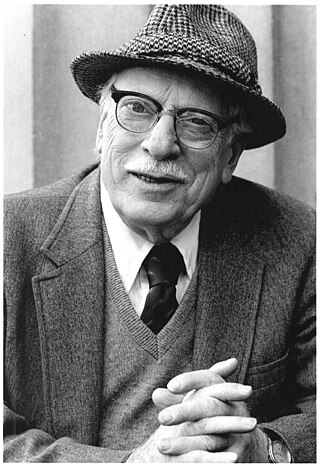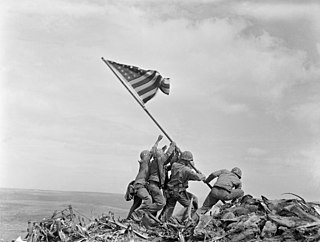The following are the Pulitzer Prizes for 1945.
Contents


The following are the Pulitzer Prizes for 1945.



William Henry Mauldin was an American editorial cartoonist who won two Pulitzer Prizes for his work. He was most famous for his World War II cartoons depicting American soldiers, as represented by the archetypal characters Willie and Joe, two weary and bedraggled infantry troopers who stoically endure the difficulties and dangers of duty in the field. His cartoons were popular with soldiers throughout Europe, and with civilians in the United States as well. However, his second Pulitzer Prize was for a cartoon published in 1958, and possibly his best-known cartoon was after the Kennedy assassination.

Joseph John Rosenthal was an American photographer who received the Pulitzer Prize for his iconic World War II photograph Raising the Flag on Iwo Jima, taken during the 1945 Battle of Iwo Jima. His picture became one of the best-known photographs of the war, and was replicated as the United States Marine Corps War Memorial in Arlington, Virginia.

Raising the Flag on Iwo Jima is an iconic photograph of six United States Marines raising the U.S. flag atop Mount Suribachi during the Battle of Iwo Jima in the final stages of the Pacific War. The photograph, taken by Joe Rosenthal of the Associated Press on February 23, 1945, was published in Sunday newspapers two days later and reprinted in thousands of publications. It won the Pulitzer Prize for Photography and was the model for the Marine Corps War Memorial in 1954, dedicated to honor all Marines who died in service since 1775. The memorial, sculpted by Felix de Weldon, is located in Arlington Ridge Park, near the Ord-Weitzel Gate to Arlington National Cemetery and the Netherlands Carillon. The photograph has come to be regarded in the United States as one of the most recognizable images of World War II.
The following are the Pulitzer Prizes for 1932.

René Arthur Gagnon was a United States Marine Corps corporal who participated in the Battle of Iwo Jima during World War II.

John Henry "Jack" "Doc" Bradley was a United States Navy Hospital corpsman who was awarded the Navy Cross for extraordinary heroism while serving with the Marines during the Battle of Iwo Jima in World War II. During the battle, he was a member of the patrol that captured the top of Mount Suribachi and raised the first U.S. flag on Iwo Jima on February 23, 1945.
The following are the Pulitzer Prizes for 1955.

The following are the Pulitzer Prizes for 1944.
The following are the Pulitzer Prizes for 1942.
The following are the Pulitzer Prizes for 1946.

The following are the Pulitzer Prizes for 1947.

The following are the Pulitzer Prizes for 1962.
Henry Oliver Hansen was a United States Marine Corps sergeant who was killed in action during the Battle of Iwo Jima in World War II. He was a member of the patrol that captured Mount Suribachi, where he helped raise the first U.S. flag on Iwo Jima on February 23, 1945. He was killed six days later.
Louis R. Lowery was a United States Marine Corps captain. He was the only Marine Corps combat photographer to cover six major campaigns during World War II. He is best known for taking the first photographs of the first American flag that was raised on top of Mount Suribachi during the Battle of Iwo Jima on the morning of February 23, 1945.

Ernest Ivy "Boots" Thomas Jr. was a United States Marine Corps platoon sergeant who was killed in action during the Battle of Iwo Jima in World War II. He was awarded the Navy Cross for extraordinary heroism while fighting for and at the base of Mount Suribachi. Two days later he was a member of the patrol that captured the top of Mount Suribachi where he helped raise the first U.S. flag on Iwo Jima on February 23, 1945. He was killed eight days after that.
Harold George Schrier was a United States Marine Corps lieutenant colonel who served in World War II and the Korean War. In World War II, he was awarded the Navy Cross for leading the patrol that captured the top of Mount Suribachi, where he helped raise the first U.S. flag on Iwo Jima on February 23, 1945. In the Korean War, he was wounded in North Korea during the Battle of Chosin Reservoir while commanding a rifle company.
Iwo Jima may refer to:
Harold Vincent "Hal" Boyle was a prolific, Pulitzer-prize-winning journalist for the Associated Press. During 30 years with the AP, Boyle wrote 7,680 columns. He is best known for his work as a war correspondent during World War II. He was consistently closer to the front lines in the European and Pacific theatres of operation than other correspondents. His column became a staple in over 700 newspapers. He is also the namesake of a prize given annually to reporters by the Oversees Press Club of America, for the best newspaper or wire service reporting from abroad.

Harold Henry Schultz was a United States Marine corporal who was wounded in action during the Battle of Iwo Jima in World War II. He was a member of the patrol that captured the top of Mount Suribachi and raised the first U.S. flag on Iwo Jima on February 23, 1945. He is also one of the six Marines who raised the larger replacement flag on the mountaintop the same day as shown in the iconic photograph Raising the Flag on Iwo Jima.

Harold Paul Keller was a United States Marine corporal who was wounded in action during the Bougainville campaign in World War II. During the Battle of Iwo Jima, he was a member of the patrol that captured the top of Mount Suribachi and raised the first U.S. flag on Iwo Jima on February 23, 1945. He is one of the six Marines who raised the larger replacement flag on the mountaintop the same day as shown in the iconic photograph Raising the Flag on Iwo Jima.